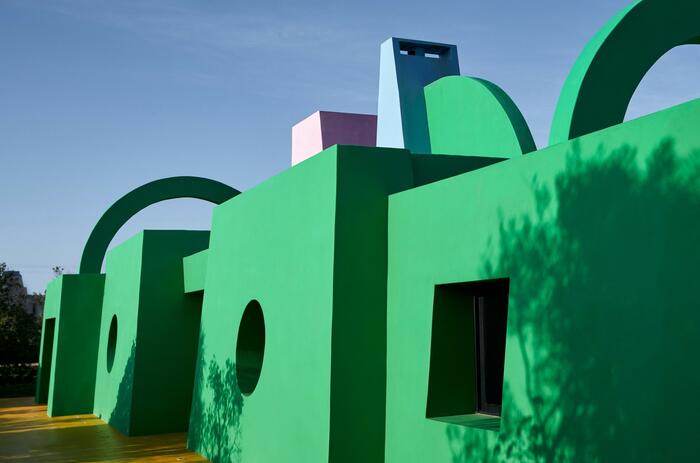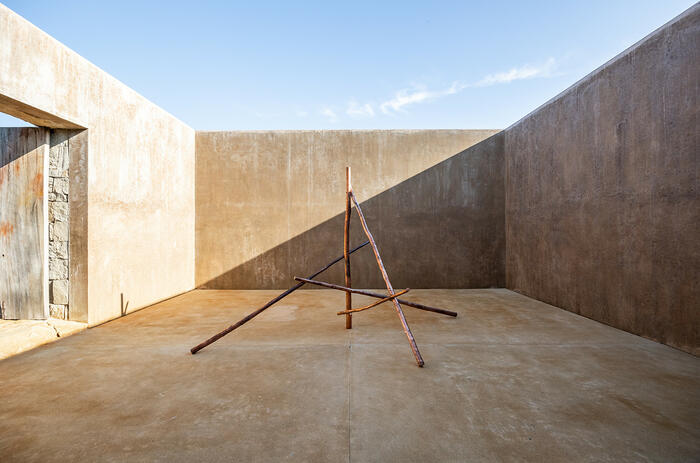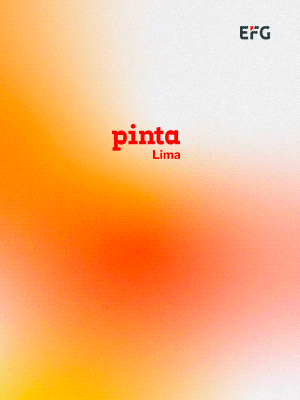AN ICE CREAM THAT DEFIES MEMORY: THE REINVENTION OF THE SHIFTING STONE
Contemporary art has become a testing ground where the boundaries between disciplines dissolve, giving way to hybrid experiences. In this shifting landscape, artist Cristian Segura introduces an unexpected provocation: an ice cream that is not only tasted but also contemplated.

Segura, whose career spans more than two decades and extends from the National Museum of Fine Arts in Buenos Aires to the Triennial of Chile, the Curitiba Biennial, the Havana Biennial, and Bienalsur, as well as exhibitions at the Carrillo Gil Museum in Mexico and the Museum of the Americas in Washington, has built a body of work that challenges notions of history and memory. In Helado Piedra Movediza (Shifting Stone Ice Cream), his latest project, the history of Tandil is literally savored in every spoonful.
On February 29, 1912, the legendary Piedra Movediza (Shifting Stone) of Tandil collapsed, marking the disappearance of a symbol that, against all logic, swayed in balance atop its granite base. More than a century later, Segura channels that loss through an edible artwork: an ice cream with a stony gray hue, a disconcerting texture, and a flavor that intrigues and lingers. "It is an ephemeral monument that vanishes as it is tasted, leaving behind a living memory, as fragile and powerful as the stone itself," the artist explains.
Helado Piedra Movediza transcends gastronomy to become a material essay on the instability of memory. Its color is not just a formalist gesture; it is a direct reference to the fragments that still lie at the foot of the hill, relics of what once defied gravity. By consuming it, the spectator does not merely participate in the artwork—they incorporate it, becoming a living archive of a memory that, like the ice cream itself, melts into the sensory experience.
The project is part of a tradition of ephemeral art that shifts the artistic object into the realm of action. "I am interested in ensuring that the spectator is not a passive observer but the very center of the work. By consuming the ice cream, their body becomes a living archive, a space where memory is activated and transformed," says Segura.
The central question of this piece is not trivial: How do we commemorate what no longer exists? How do we preserve a symbol whose essence lay in its improbable balance? Helado Piedra Movediza responds to these questions through dissolution itself: the solid becomes fleeting, the permanent is relativized, and history turns into an immediate experience.
This is not a work about nostalgia; it is a work about the fragility of monuments and the persistence of memory in unexpected forms. "The mineral gray evokes the texture and materiality of the original stone, allowing the spectator to establish a direct connection with its history," Segura notes. "It is an ephemeral monument that, in its fragility, challenges the conventions of art and memory. It lives in the bodies and stories of those who experience it."
The Piedra Movediza, with its 300 tons of improbable oscillation, was for centuries an icon of instability within the seemingly eternal. In this reinterpretation, Segura translates that instability to the palate, transforming its absence into a gesture that is consumed and, in doing so, persists. Helado Piedra Movediza is, ultimately, a question about the nature of permanence. And like all great art, it offers no easy answers.
Related Topics
May interest you

A new group exhibition brings together 17 Argentine artists in New York. Curated by The Bureau of The Unknown Curator, the show features Cecilia Biagini, Ivana Brenner, Rafael Bueno, Bibi Calderaro, Beto De Volder, Dolores Furtado, Julio Grinblatt, Nicolás Guagnini, Claudia Kaatziza Cortínez, Syd Krochmalny, Fabián Marcaccio, Sabrina Merayo Núñez, Luciana Pinchiero, Liliana Porter, Sofía Quirno, Analia Segal, and Pedro Wainer.
THE ARGENTINE INTERNATIONAL AT THE SLIP GALLERY
A new group exhibition brings together 17 Argentine artists in New York. Curated by The Bureau of The Unknown Curator, the show features Cecilia Biagini, Ivana Brenner, Rafael Bueno, Bibi Calderaro, Beto De Volder, Dolores Furtado, Julio Grinblatt, Nicolás Guagnini, Claudia Kaatziza Cortínez, Syd Krochmalny, Fabián Marcaccio, Sabrina Merayo Núñez, Luciana Pinchiero, Liliana Porter, Sofía Quirno, Analia Segal, and Pedro Wainer.

A new group exhibition brings together 17 Argentine artists in New York. Curated by The Bureau of The Unknown Curator, the show features Cecilia Biagini, Ivana Brenner, Rafael Bueno, Bibi Calderaro, Beto De Volder, Dolores Furtado, Julio Grinblatt, Nicolás Guagnini, Claudia Kaatziza Cortínez, Syd Krochmalny, Fabián Marcaccio, Sabrina Merayo Núñez, Luciana Pinchiero, Liliana Porter, Sofía Quirno, Analia Segal, and Pedro Wainer.
THE ARGENTINE INTERNATIONAL AT THE SLIP GALLERY
A new group exhibition brings together 17 Argentine artists in New York. Curated by The Bureau of The Unknown Curator, the show features Cecilia Biagini, Ivana Brenner, Rafael Bueno, Bibi Calderaro, Beto De Volder, Dolores Furtado, Julio Grinblatt, Nicolás Guagnini, Claudia Kaatziza Cortínez, Syd Krochmalny, Fabián Marcaccio, Sabrina Merayo Núñez, Luciana Pinchiero, Liliana Porter, Sofía Quirno, Analia Segal, and Pedro Wainer.

The Vilcek Foundation has named Argentine Director and Chief Curator of Art Aimé Iglesias Lukin as one of the three recipients of the Vilcek Prize for Creative Promise in Curatorial Work. The award recognizes immigrant contributions to the arts and sciences in the United States.
AIMÉ IGLESIAS LUKIN IS THE WINNER OF THE VILCEK AWARD
The Vilcek Foundation has named Argentine Director and Chief Curator of Art Aimé Iglesias Lukin as one of the three recipients of the Vilcek Prize for Creative Promise in Curatorial Work. The award recognizes immigrant contributions to the arts and sciences in the United States.

The Center for Art, Research and Alliances (CARA) spring 2025 exhibition, continents like seeds, brings together the work of La Chola Poblete (b. 1989, Argentina), Niño de Elche (b. 1985, Spain), and Pedro G. Romero (b. 1964, Spain); through sound, sculpture, performance, drawing, and painting, the show unravels and exposes the contradictions and ambiguities of colonial legacies.
QUESTIONING TRADITIONS AT CARA
The Center for Art, Research and Alliances (CARA) spring 2025 exhibition, continents like seeds, brings together the work of La Chola Poblete (b. 1989, Argentina), Niño de Elche (b. 1985, Spain), and Pedro G. Romero (b. 1964, Spain); through sound, sculpture, performance, drawing, and painting, the show unravels and exposes the contradictions and ambiguities of colonial legacies.

Fundación Ama Amoedo announced the selection for the FAARA Residency 2025 at its emblematic Casa Neptuna in José Ignacio, Uruguay.
FAARA 2025 RESIDENCY: THE SIX SELECTED ARTISTS
Fundación Ama Amoedo announced the selection for the FAARA Residency 2025 at its emblematic Casa Neptuna in José Ignacio, Uruguay.

Located in KM 113 of the federal highway that connects Salina Cruz to Pinotepa Nacional, a remote creative jewel stands. Architecture, design, and art cohabit along this section of the Oaxacan coast. A mix of boutique accommodations, gastronomy, and contemporary art proposals enrich Puerto Escondido’s endowment of inspiration and creation.
THROUGH WEAVING AND THREADS, CHIHARU SHIOTA AND XIMENA GARRIDO-LECCA CREATE A WORLD OF THEIR OWN IN PUERTO ESCONDIDO
Located in KM 113 of the federal highway that connects Salina Cruz to Pinotepa Nacional, a remote creative jewel stands. Architecture, design, and art cohabit along this section of the Oaxacan coast. A mix of boutique accommodations, gastronomy, and contemporary art proposals enrich Puerto Escondido’s endowment of inspiration and creation.

A new group exhibition brings together 17 Argentine artists in New York. Curated by The Bureau of The Unknown Curator, the show features Cecilia Biagini, Ivana Brenner, Rafael Bueno, Bibi Calderaro, Beto De Volder, Dolores Furtado, Julio Grinblatt, Nicolás Guagnini, Claudia Kaatziza Cortínez, Syd Krochmalny, Fabián Marcaccio, Sabrina Merayo Núñez, Luciana Pinchiero, Liliana Porter, Sofía Quirno, Analia Segal, and Pedro Wainer.
THE ARGENTINE INTERNATIONAL AT THE SLIP GALLERY
A new group exhibition brings together 17 Argentine artists in New York. Curated by The Bureau of The Unknown Curator, the show features Cecilia Biagini, Ivana Brenner, Rafael Bueno, Bibi Calderaro, Beto De Volder, Dolores Furtado, Julio Grinblatt, Nicolás Guagnini, Claudia Kaatziza Cortínez, Syd Krochmalny, Fabián Marcaccio, Sabrina Merayo Núñez, Luciana Pinchiero, Liliana Porter, Sofía Quirno, Analia Segal, and Pedro Wainer.

The Vilcek Foundation has named Argentine Director and Chief Curator of Art Aimé Iglesias Lukin as one of the three recipients of the Vilcek Prize for Creative Promise in Curatorial Work. The award recognizes immigrant contributions to the arts and sciences in the United States.
AIMÉ IGLESIAS LUKIN IS THE WINNER OF THE VILCEK AWARD
The Vilcek Foundation has named Argentine Director and Chief Curator of Art Aimé Iglesias Lukin as one of the three recipients of the Vilcek Prize for Creative Promise in Curatorial Work. The award recognizes immigrant contributions to the arts and sciences in the United States.

The Center for Art, Research and Alliances (CARA) spring 2025 exhibition, continents like seeds, brings together the work of La Chola Poblete (b. 1989, Argentina), Niño de Elche (b. 1985, Spain), and Pedro G. Romero (b. 1964, Spain); through sound, sculpture, performance, drawing, and painting, the show unravels and exposes the contradictions and ambiguities of colonial legacies.
QUESTIONING TRADITIONS AT CARA
The Center for Art, Research and Alliances (CARA) spring 2025 exhibition, continents like seeds, brings together the work of La Chola Poblete (b. 1989, Argentina), Niño de Elche (b. 1985, Spain), and Pedro G. Romero (b. 1964, Spain); through sound, sculpture, performance, drawing, and painting, the show unravels and exposes the contradictions and ambiguities of colonial legacies.

Fundación Ama Amoedo announced the selection for the FAARA Residency 2025 at its emblematic Casa Neptuna in José Ignacio, Uruguay.
FAARA 2025 RESIDENCY: THE SIX SELECTED ARTISTS
Fundación Ama Amoedo announced the selection for the FAARA Residency 2025 at its emblematic Casa Neptuna in José Ignacio, Uruguay.

Located in KM 113 of the federal highway that connects Salina Cruz to Pinotepa Nacional, a remote creative jewel stands. Architecture, design, and art cohabit along this section of the Oaxacan coast. A mix of boutique accommodations, gastronomy, and contemporary art proposals enrich Puerto Escondido’s endowment of inspiration and creation.
THROUGH WEAVING AND THREADS, CHIHARU SHIOTA AND XIMENA GARRIDO-LECCA CREATE A WORLD OF THEIR OWN IN PUERTO ESCONDIDO
Located in KM 113 of the federal highway that connects Salina Cruz to Pinotepa Nacional, a remote creative jewel stands. Architecture, design, and art cohabit along this section of the Oaxacan coast. A mix of boutique accommodations, gastronomy, and contemporary art proposals enrich Puerto Escondido’s endowment of inspiration and creation.

A new group exhibition brings together 17 Argentine artists in New York. Curated by The Bureau of The Unknown Curator, the show features Cecilia Biagini, Ivana Brenner, Rafael Bueno, Bibi Calderaro, Beto De Volder, Dolores Furtado, Julio Grinblatt, Nicolás Guagnini, Claudia Kaatziza Cortínez, Syd Krochmalny, Fabián Marcaccio, Sabrina Merayo Núñez, Luciana Pinchiero, Liliana Porter, Sofía Quirno, Analia Segal, and Pedro Wainer.
THE ARGENTINE INTERNATIONAL AT THE SLIP GALLERY
A new group exhibition brings together 17 Argentine artists in New York. Curated by The Bureau of The Unknown Curator, the show features Cecilia Biagini, Ivana Brenner, Rafael Bueno, Bibi Calderaro, Beto De Volder, Dolores Furtado, Julio Grinblatt, Nicolás Guagnini, Claudia Kaatziza Cortínez, Syd Krochmalny, Fabián Marcaccio, Sabrina Merayo Núñez, Luciana Pinchiero, Liliana Porter, Sofía Quirno, Analia Segal, and Pedro Wainer.

The Vilcek Foundation has named Argentine Director and Chief Curator of Art Aimé Iglesias Lukin as one of the three recipients of the Vilcek Prize for Creative Promise in Curatorial Work. The award recognizes immigrant contributions to the arts and sciences in the United States.
AIMÉ IGLESIAS LUKIN IS THE WINNER OF THE VILCEK AWARD
The Vilcek Foundation has named Argentine Director and Chief Curator of Art Aimé Iglesias Lukin as one of the three recipients of the Vilcek Prize for Creative Promise in Curatorial Work. The award recognizes immigrant contributions to the arts and sciences in the United States.

The Center for Art, Research and Alliances (CARA) spring 2025 exhibition, continents like seeds, brings together the work of La Chola Poblete (b. 1989, Argentina), Niño de Elche (b. 1985, Spain), and Pedro G. Romero (b. 1964, Spain); through sound, sculpture, performance, drawing, and painting, the show unravels and exposes the contradictions and ambiguities of colonial legacies.
QUESTIONING TRADITIONS AT CARA
The Center for Art, Research and Alliances (CARA) spring 2025 exhibition, continents like seeds, brings together the work of La Chola Poblete (b. 1989, Argentina), Niño de Elche (b. 1985, Spain), and Pedro G. Romero (b. 1964, Spain); through sound, sculpture, performance, drawing, and painting, the show unravels and exposes the contradictions and ambiguities of colonial legacies.

Fundación Ama Amoedo announced the selection for the FAARA Residency 2025 at its emblematic Casa Neptuna in José Ignacio, Uruguay.
FAARA 2025 RESIDENCY: THE SIX SELECTED ARTISTS
Fundación Ama Amoedo announced the selection for the FAARA Residency 2025 at its emblematic Casa Neptuna in José Ignacio, Uruguay.

Located in KM 113 of the federal highway that connects Salina Cruz to Pinotepa Nacional, a remote creative jewel stands. Architecture, design, and art cohabit along this section of the Oaxacan coast. A mix of boutique accommodations, gastronomy, and contemporary art proposals enrich Puerto Escondido’s endowment of inspiration and creation.
THROUGH WEAVING AND THREADS, CHIHARU SHIOTA AND XIMENA GARRIDO-LECCA CREATE A WORLD OF THEIR OWN IN PUERTO ESCONDIDO
Located in KM 113 of the federal highway that connects Salina Cruz to Pinotepa Nacional, a remote creative jewel stands. Architecture, design, and art cohabit along this section of the Oaxacan coast. A mix of boutique accommodations, gastronomy, and contemporary art proposals enrich Puerto Escondido’s endowment of inspiration and creation.

A new group exhibition brings together 17 Argentine artists in New York. Curated by The Bureau of The Unknown Curator, the show features Cecilia Biagini, Ivana Brenner, Rafael Bueno, Bibi Calderaro, Beto De Volder, Dolores Furtado, Julio Grinblatt, Nicolás Guagnini, Claudia Kaatziza Cortínez, Syd Krochmalny, Fabián Marcaccio, Sabrina Merayo Núñez, Luciana Pinchiero, Liliana Porter, Sofía Quirno, Analia Segal, and Pedro Wainer.
THE ARGENTINE INTERNATIONAL AT THE SLIP GALLERY
A new group exhibition brings together 17 Argentine artists in New York. Curated by The Bureau of The Unknown Curator, the show features Cecilia Biagini, Ivana Brenner, Rafael Bueno, Bibi Calderaro, Beto De Volder, Dolores Furtado, Julio Grinblatt, Nicolás Guagnini, Claudia Kaatziza Cortínez, Syd Krochmalny, Fabián Marcaccio, Sabrina Merayo Núñez, Luciana Pinchiero, Liliana Porter, Sofía Quirno, Analia Segal, and Pedro Wainer.

The Vilcek Foundation has named Argentine Director and Chief Curator of Art Aimé Iglesias Lukin as one of the three recipients of the Vilcek Prize for Creative Promise in Curatorial Work. The award recognizes immigrant contributions to the arts and sciences in the United States.
AIMÉ IGLESIAS LUKIN IS THE WINNER OF THE VILCEK AWARD
The Vilcek Foundation has named Argentine Director and Chief Curator of Art Aimé Iglesias Lukin as one of the three recipients of the Vilcek Prize for Creative Promise in Curatorial Work. The award recognizes immigrant contributions to the arts and sciences in the United States.

The Center for Art, Research and Alliances (CARA) spring 2025 exhibition, continents like seeds, brings together the work of La Chola Poblete (b. 1989, Argentina), Niño de Elche (b. 1985, Spain), and Pedro G. Romero (b. 1964, Spain); through sound, sculpture, performance, drawing, and painting, the show unravels and exposes the contradictions and ambiguities of colonial legacies.
QUESTIONING TRADITIONS AT CARA
The Center for Art, Research and Alliances (CARA) spring 2025 exhibition, continents like seeds, brings together the work of La Chola Poblete (b. 1989, Argentina), Niño de Elche (b. 1985, Spain), and Pedro G. Romero (b. 1964, Spain); through sound, sculpture, performance, drawing, and painting, the show unravels and exposes the contradictions and ambiguities of colonial legacies.

Fundación Ama Amoedo announced the selection for the FAARA Residency 2025 at its emblematic Casa Neptuna in José Ignacio, Uruguay.
FAARA 2025 RESIDENCY: THE SIX SELECTED ARTISTS
Fundación Ama Amoedo announced the selection for the FAARA Residency 2025 at its emblematic Casa Neptuna in José Ignacio, Uruguay.

Located in KM 113 of the federal highway that connects Salina Cruz to Pinotepa Nacional, a remote creative jewel stands. Architecture, design, and art cohabit along this section of the Oaxacan coast. A mix of boutique accommodations, gastronomy, and contemporary art proposals enrich Puerto Escondido’s endowment of inspiration and creation.
THROUGH WEAVING AND THREADS, CHIHARU SHIOTA AND XIMENA GARRIDO-LECCA CREATE A WORLD OF THEIR OWN IN PUERTO ESCONDIDO
Located in KM 113 of the federal highway that connects Salina Cruz to Pinotepa Nacional, a remote creative jewel stands. Architecture, design, and art cohabit along this section of the Oaxacan coast. A mix of boutique accommodations, gastronomy, and contemporary art proposals enrich Puerto Escondido’s endowment of inspiration and creation.

A new group exhibition brings together 17 Argentine artists in New York. Curated by The Bureau of The Unknown Curator, the show features Cecilia Biagini, Ivana Brenner, Rafael Bueno, Bibi Calderaro, Beto De Volder, Dolores Furtado, Julio Grinblatt, Nicolás Guagnini, Claudia Kaatziza Cortínez, Syd Krochmalny, Fabián Marcaccio, Sabrina Merayo Núñez, Luciana Pinchiero, Liliana Porter, Sofía Quirno, Analia Segal, and Pedro Wainer.
THE ARGENTINE INTERNATIONAL AT THE SLIP GALLERY
A new group exhibition brings together 17 Argentine artists in New York. Curated by The Bureau of The Unknown Curator, the show features Cecilia Biagini, Ivana Brenner, Rafael Bueno, Bibi Calderaro, Beto De Volder, Dolores Furtado, Julio Grinblatt, Nicolás Guagnini, Claudia Kaatziza Cortínez, Syd Krochmalny, Fabián Marcaccio, Sabrina Merayo Núñez, Luciana Pinchiero, Liliana Porter, Sofía Quirno, Analia Segal, and Pedro Wainer.

The Vilcek Foundation has named Argentine Director and Chief Curator of Art Aimé Iglesias Lukin as one of the three recipients of the Vilcek Prize for Creative Promise in Curatorial Work. The award recognizes immigrant contributions to the arts and sciences in the United States.
AIMÉ IGLESIAS LUKIN IS THE WINNER OF THE VILCEK AWARD
The Vilcek Foundation has named Argentine Director and Chief Curator of Art Aimé Iglesias Lukin as one of the three recipients of the Vilcek Prize for Creative Promise in Curatorial Work. The award recognizes immigrant contributions to the arts and sciences in the United States.

The Center for Art, Research and Alliances (CARA) spring 2025 exhibition, continents like seeds, brings together the work of La Chola Poblete (b. 1989, Argentina), Niño de Elche (b. 1985, Spain), and Pedro G. Romero (b. 1964, Spain); through sound, sculpture, performance, drawing, and painting, the show unravels and exposes the contradictions and ambiguities of colonial legacies.
QUESTIONING TRADITIONS AT CARA
The Center for Art, Research and Alliances (CARA) spring 2025 exhibition, continents like seeds, brings together the work of La Chola Poblete (b. 1989, Argentina), Niño de Elche (b. 1985, Spain), and Pedro G. Romero (b. 1964, Spain); through sound, sculpture, performance, drawing, and painting, the show unravels and exposes the contradictions and ambiguities of colonial legacies.

Fundación Ama Amoedo announced the selection for the FAARA Residency 2025 at its emblematic Casa Neptuna in José Ignacio, Uruguay.
FAARA 2025 RESIDENCY: THE SIX SELECTED ARTISTS
Fundación Ama Amoedo announced the selection for the FAARA Residency 2025 at its emblematic Casa Neptuna in José Ignacio, Uruguay.

Located in KM 113 of the federal highway that connects Salina Cruz to Pinotepa Nacional, a remote creative jewel stands. Architecture, design, and art cohabit along this section of the Oaxacan coast. A mix of boutique accommodations, gastronomy, and contemporary art proposals enrich Puerto Escondido’s endowment of inspiration and creation.
THROUGH WEAVING AND THREADS, CHIHARU SHIOTA AND XIMENA GARRIDO-LECCA CREATE A WORLD OF THEIR OWN IN PUERTO ESCONDIDO
Located in KM 113 of the federal highway that connects Salina Cruz to Pinotepa Nacional, a remote creative jewel stands. Architecture, design, and art cohabit along this section of the Oaxacan coast. A mix of boutique accommodations, gastronomy, and contemporary art proposals enrich Puerto Escondido’s endowment of inspiration and creation.




